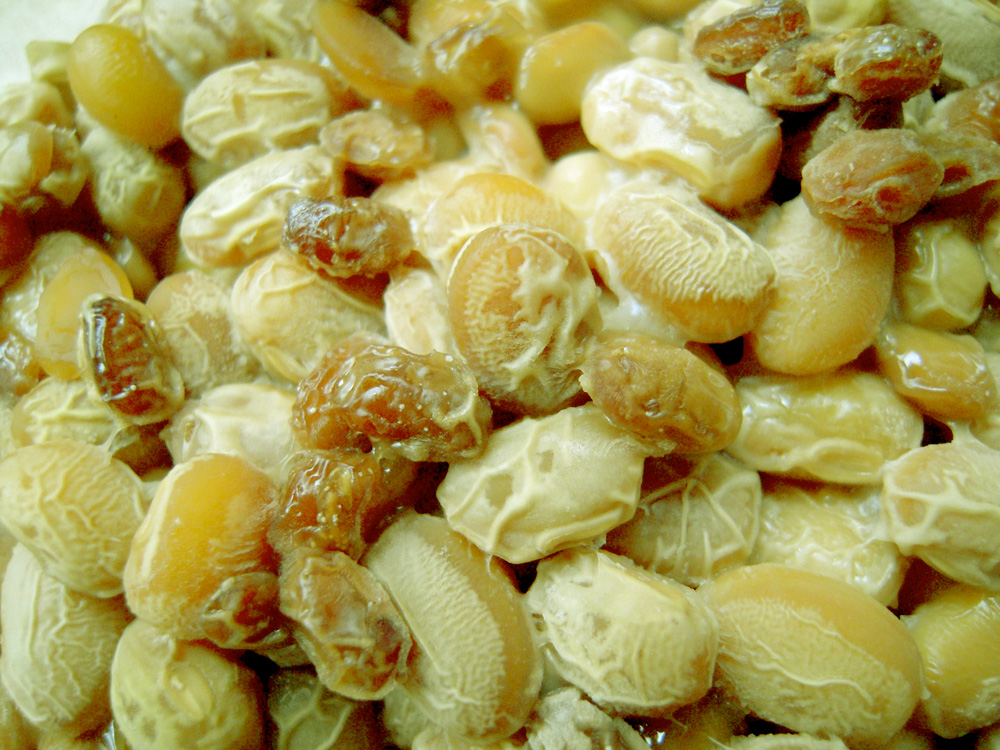
Natto is the one of those foods that elicits strong reactions. I get overwhelmed with a sense of joy and excitement, but the response I hear from most people (who aren't from or aren't descendants of the eastern regions of Japan) is pure disgust.
I remember how clueless I was junior year in college when I stocked up on natto and brought it back to my fridge that I shared with four other UC Santa Cruzers. As I was innocently devouring a package of natto, my roommate barged in yelling "Oh my god! What is that smell?!" My answer to her was, "Are you talking about your pet rat?" as I gestured my chopsticks (all stringy with natto strands) to point at the corner of the room where her pet rat resided. She shook her head and inched in closer to me to inspect the contents of my bowl.
It never registered to me that cold food could smell -- and up until that point, I never suspected that natto even had a smell.
That was my first lesson in how natto could offend people. From that day forward, I could not eat natto so long as I lived with roommates.
Natto is fermented soybeans that were traditionally made in
kotatsus in Japanese homes in the Kanto (Tokyo) region. It's like yogurt in the way that you start with a culture. In the case of natto, the culture used is bacillus subtilis and the medium is soybeans which are left in a humid, warm environment for 24 hours. The result is a mixture of stringy, luscious soybeans that are kind of like a soft cheese in texture with an aroma like no other. Some describe it like smelly French cheese... while my roommates told me it smelled like feet.
Natto is getting some attention because of its health benefits. Eastern regions of Japan have less incidence of osteoporosis. Plus, that sticky stuff apparently contains some enzymes that thin the blood, therefore, preventing heart attacks, strokes and certain types of cancers. I guess they even sell natto in pill form and call it "Nattokinase" here in the west.
My love for natto was evident from my early days -- soon after I exited the womb. But our bond strengthened exponentially when I moved to Tokyo where I could indulge in my love for it with no shame or judgment from my peers. Plus they were regularly priced at a dirt-cheap 30-cents a serving. I would eat a package every morning before dashing off to work. It was like my daily cup of coffee.
So when I came back to the U.S. last month, I braced myself for an environment that would challenge my love affair with natto. It's not that expensive here in California at about $2.00 for three servings, but that's still about twice the amount I was used to in Tokyo. Plus, it's not readily available, say at the local 7-11 or Safeway.
I concluded that the only way I could rely on a steady and affordable supply of natto was to make it myself. My experience with making yogurt for four years, gave me the confidence to try my hand at natto as well.
Here's how I made it:
1) Gather together the following ingredients and supplies: 1 lb of soybeans, a store bought pack of natto, water, glass containers, foil

2) Soak soybeans overnight in plenty of water.

After one night:
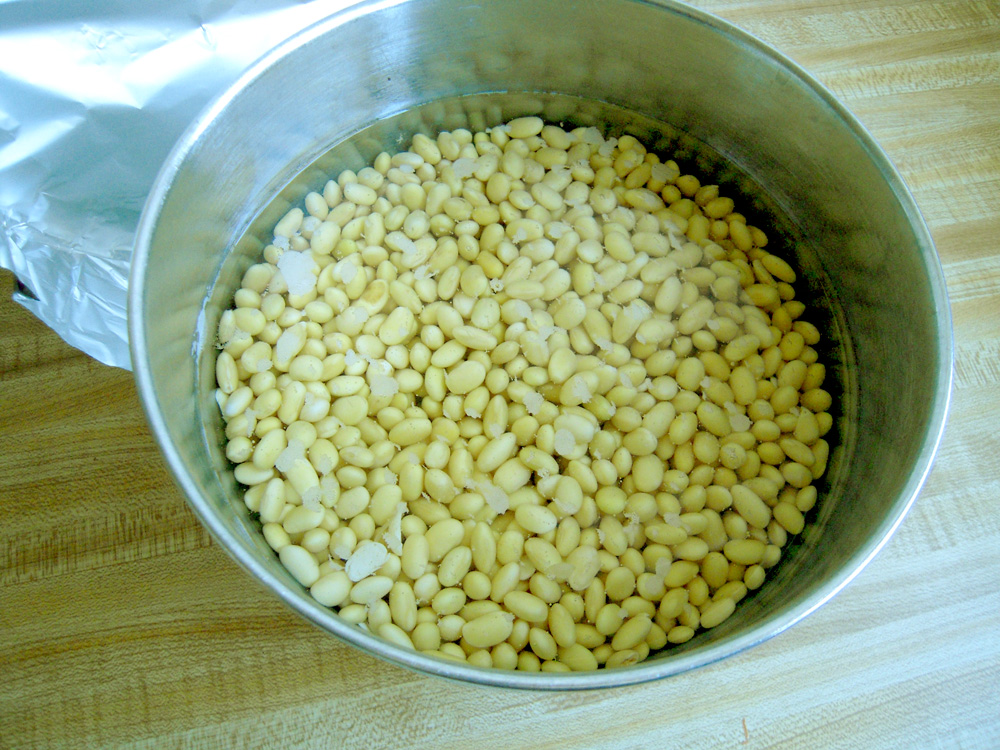
3) Drain the soybeans.

4) Steam the soybeans until you can smush them between your thumb and pointer finger.
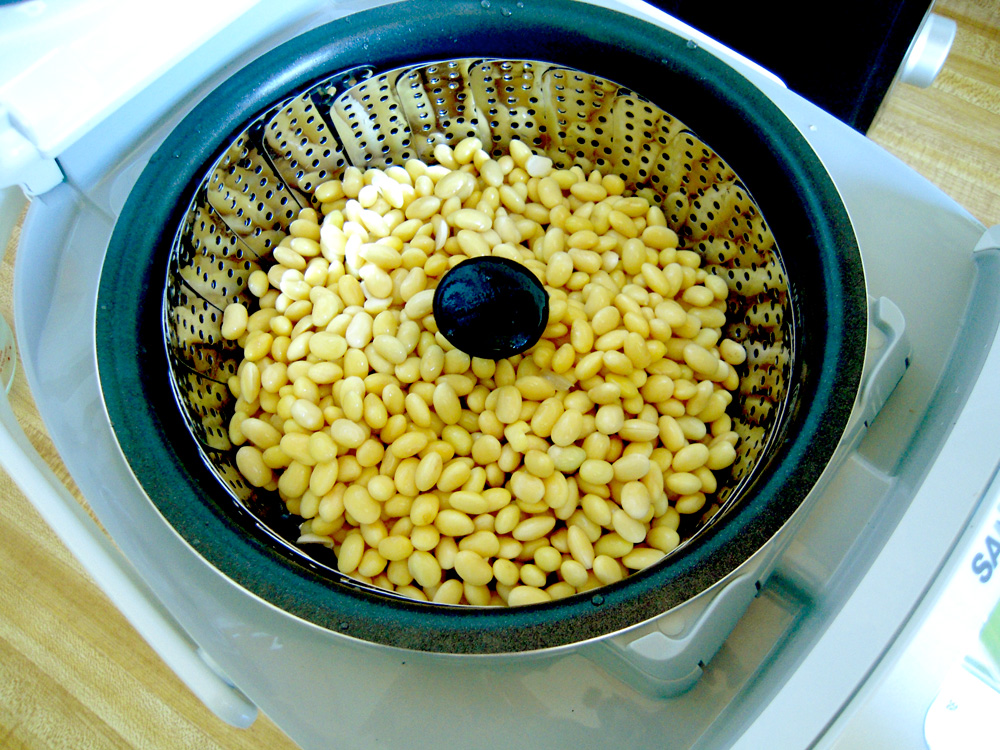
I used my rice cooker which also can act as a pressure cooker. I ended up steaming the soybeans for 40 minutes.
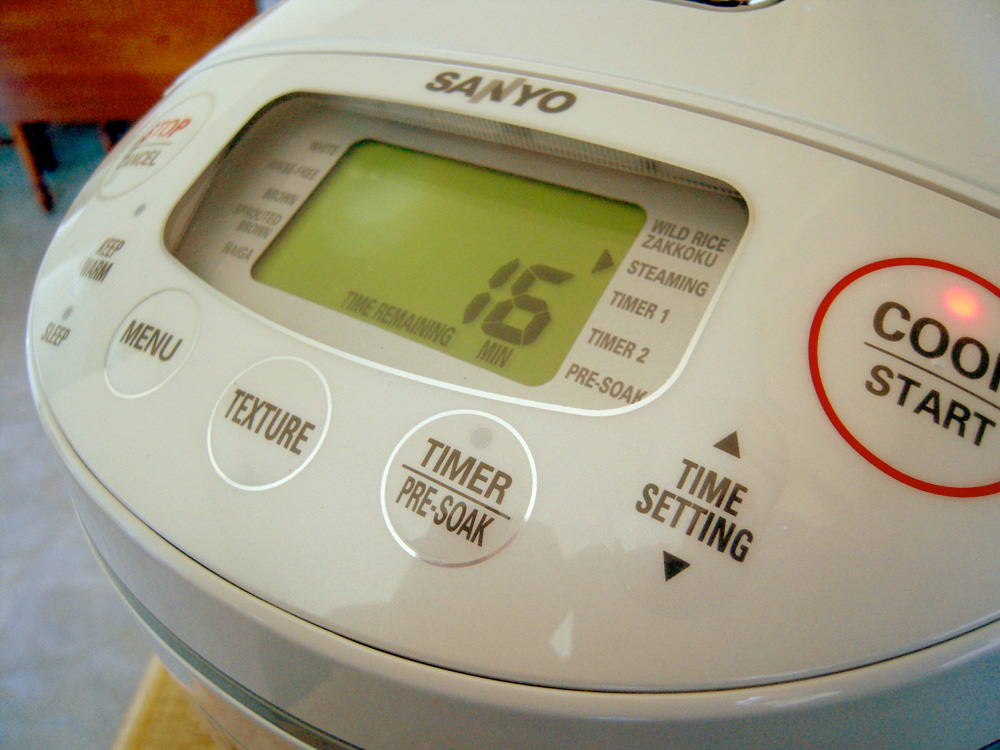
5) While the soybeans are steaming, sterilize the glass containers you will use to ferment the soybeans in. I set my oven to 250 degrees and placed my glass containers in there for about 30 minutes.
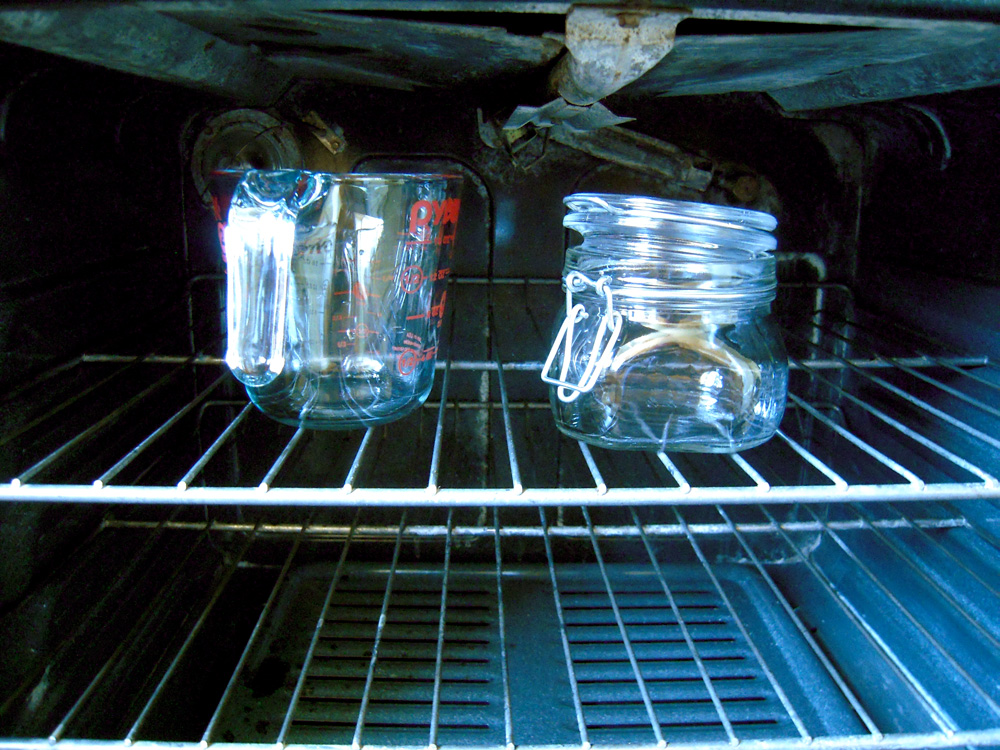
6) Break out the store-bought package of natto.
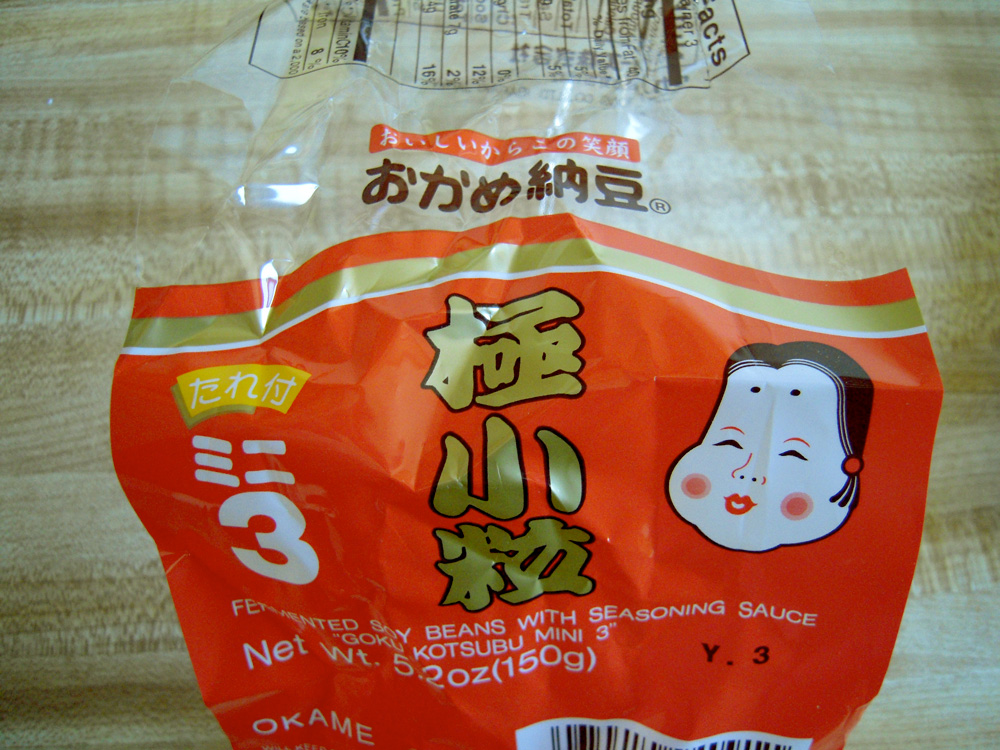

7) Once the soybeans are done steaming, combine them with the store-bought package of natto.

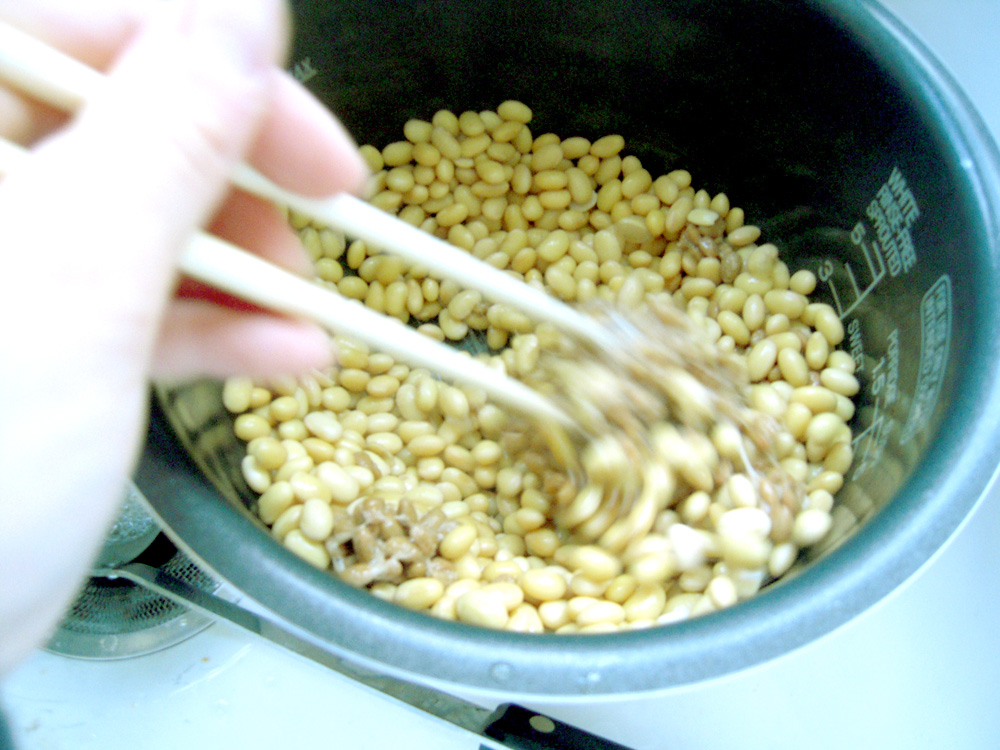
8) Mix well then place the beans into the sterilized jars. Cover the jars with aluminum foil. Poke holes in the foil so that the soybeans can "breathe" during the fermentation process.


9) Okay, the beans are now ready to ferment. The basic idea for creating an ideal environment is to keep the beans in a humid, warm climate at about 40 degrees celsius (think mid-August Tokyo in a small room on the fourth floor with no windows and air conditioning). So I decided to keep the jars in my Crock-pot filled with a little bit of water on the "warm" setting. People also seem to use ice boxes filled with hot water bottles.
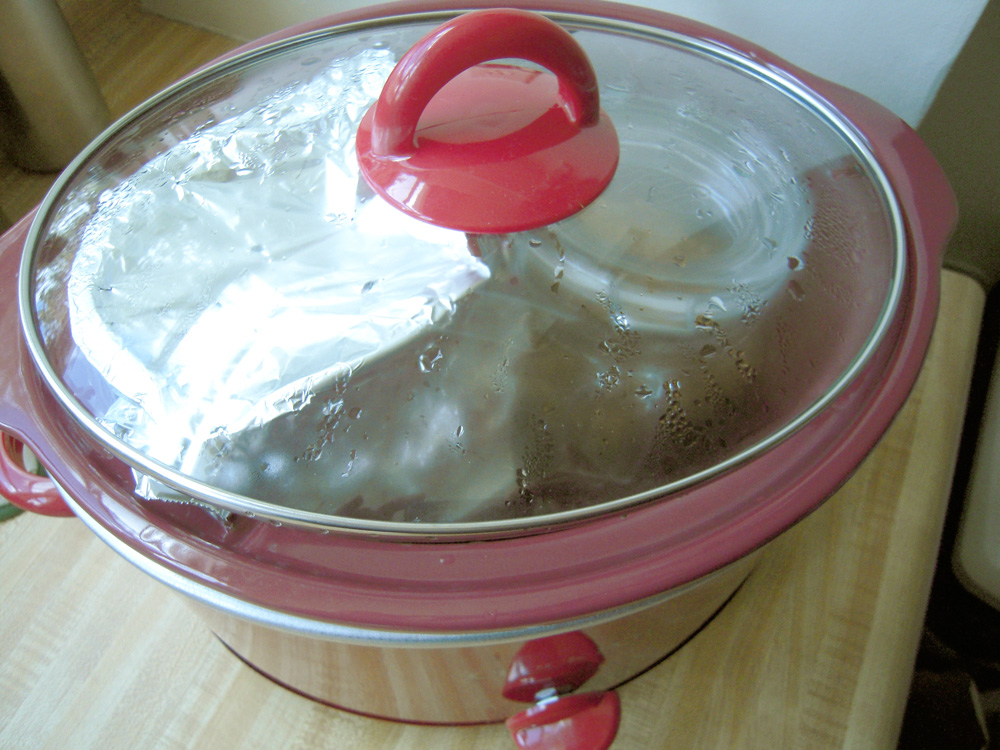
10) Wait for 24 hours.
The suspense got the best of me and I took a peek inside after 12 hours:
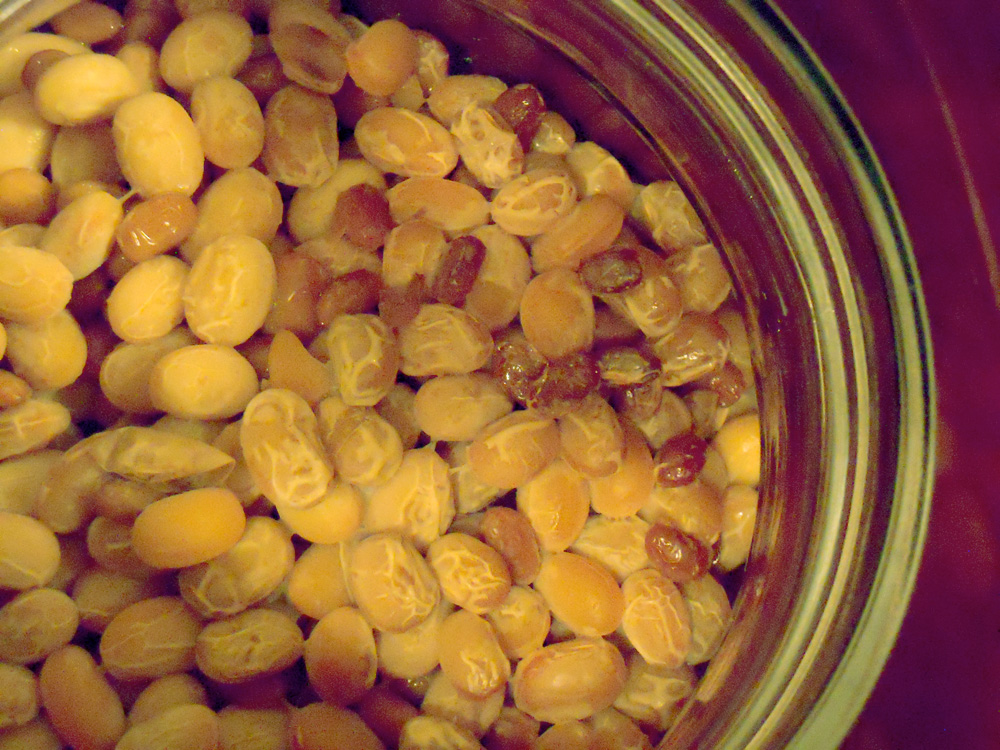
And the next morning they really seemed all mature and grown up.

Look at the stringiness!!! I was a very proud parent.

11) But the wait was not over. These beads of joy must be aged for umami in air-tight containers for a few days to one week in the refrigerator.
12) I finally got to indulge today over rice and I experienced a deep sense of pride and accomplishment. With a dash of soy sauce and Japanese mustard mixed into my home-made natto, I knew I had achieved nirvana for my taste buds and wallet.


13) To complete the cycle, freeze a portion of the natto to use as the starter for the next batch of natto.
 Natto is the one of those foods that elicits strong reactions. I get overwhelmed with a sense of joy and excitement, but the response I hear from most people (who aren't from or aren't descendants of the eastern regions of Japan) is pure disgust.
I remember how clueless I was junior year in college when I stocked up on natto and brought it back to my fridge that I shared with four other UC Santa Cruzers. As I was innocently devouring a package of natto, my roommate barged in yelling "Oh my god! What is that smell?!" My answer to her was, "Are you talking about your pet rat?" as I gestured my chopsticks (all stringy with natto strands) to point at the corner of the room where her pet rat resided. She shook her head and inched in closer to me to inspect the contents of my bowl.
It never registered to me that cold food could smell -- and up until that point, I never suspected that natto even had a smell.
That was my first lesson in how natto could offend people. From that day forward, I could not eat natto so long as I lived with roommates.
Natto is fermented soybeans that were traditionally made in kotatsus in Japanese homes in the Kanto (Tokyo) region. It's like yogurt in the way that you start with a culture. In the case of natto, the culture used is bacillus subtilis and the medium is soybeans which are left in a humid, warm environment for 24 hours. The result is a mixture of stringy, luscious soybeans that are kind of like a soft cheese in texture with an aroma like no other. Some describe it like smelly French cheese... while my roommates told me it smelled like feet.
Natto is getting some attention because of its health benefits. Eastern regions of Japan have less incidence of osteoporosis. Plus, that sticky stuff apparently contains some enzymes that thin the blood, therefore, preventing heart attacks, strokes and certain types of cancers. I guess they even sell natto in pill form and call it "Nattokinase" here in the west.
My love for natto was evident from my early days -- soon after I exited the womb. But our bond strengthened exponentially when I moved to Tokyo where I could indulge in my love for it with no shame or judgment from my peers. Plus they were regularly priced at a dirt-cheap 30-cents a serving. I would eat a package every morning before dashing off to work. It was like my daily cup of coffee.
So when I came back to the U.S. last month, I braced myself for an environment that would challenge my love affair with natto. It's not that expensive here in California at about $2.00 for three servings, but that's still about twice the amount I was used to in Tokyo. Plus, it's not readily available, say at the local 7-11 or Safeway.
I concluded that the only way I could rely on a steady and affordable supply of natto was to make it myself. My experience with making yogurt for four years, gave me the confidence to try my hand at natto as well.
Here's how I made it:
1) Gather together the following ingredients and supplies: 1 lb of soybeans, a store bought pack of natto, water, glass containers, foil
Natto is the one of those foods that elicits strong reactions. I get overwhelmed with a sense of joy and excitement, but the response I hear from most people (who aren't from or aren't descendants of the eastern regions of Japan) is pure disgust.
I remember how clueless I was junior year in college when I stocked up on natto and brought it back to my fridge that I shared with four other UC Santa Cruzers. As I was innocently devouring a package of natto, my roommate barged in yelling "Oh my god! What is that smell?!" My answer to her was, "Are you talking about your pet rat?" as I gestured my chopsticks (all stringy with natto strands) to point at the corner of the room where her pet rat resided. She shook her head and inched in closer to me to inspect the contents of my bowl.
It never registered to me that cold food could smell -- and up until that point, I never suspected that natto even had a smell.
That was my first lesson in how natto could offend people. From that day forward, I could not eat natto so long as I lived with roommates.
Natto is fermented soybeans that were traditionally made in kotatsus in Japanese homes in the Kanto (Tokyo) region. It's like yogurt in the way that you start with a culture. In the case of natto, the culture used is bacillus subtilis and the medium is soybeans which are left in a humid, warm environment for 24 hours. The result is a mixture of stringy, luscious soybeans that are kind of like a soft cheese in texture with an aroma like no other. Some describe it like smelly French cheese... while my roommates told me it smelled like feet.
Natto is getting some attention because of its health benefits. Eastern regions of Japan have less incidence of osteoporosis. Plus, that sticky stuff apparently contains some enzymes that thin the blood, therefore, preventing heart attacks, strokes and certain types of cancers. I guess they even sell natto in pill form and call it "Nattokinase" here in the west.
My love for natto was evident from my early days -- soon after I exited the womb. But our bond strengthened exponentially when I moved to Tokyo where I could indulge in my love for it with no shame or judgment from my peers. Plus they were regularly priced at a dirt-cheap 30-cents a serving. I would eat a package every morning before dashing off to work. It was like my daily cup of coffee.
So when I came back to the U.S. last month, I braced myself for an environment that would challenge my love affair with natto. It's not that expensive here in California at about $2.00 for three servings, but that's still about twice the amount I was used to in Tokyo. Plus, it's not readily available, say at the local 7-11 or Safeway.
I concluded that the only way I could rely on a steady and affordable supply of natto was to make it myself. My experience with making yogurt for four years, gave me the confidence to try my hand at natto as well.
Here's how I made it:
1) Gather together the following ingredients and supplies: 1 lb of soybeans, a store bought pack of natto, water, glass containers, foil
 2) Soak soybeans overnight in plenty of water.
2) Soak soybeans overnight in plenty of water.
 After one night:
After one night:
 3) Drain the soybeans.
3) Drain the soybeans.
 4) Steam the soybeans until you can smush them between your thumb and pointer finger.
4) Steam the soybeans until you can smush them between your thumb and pointer finger.
 I used my rice cooker which also can act as a pressure cooker. I ended up steaming the soybeans for 40 minutes.
I used my rice cooker which also can act as a pressure cooker. I ended up steaming the soybeans for 40 minutes.
 5) While the soybeans are steaming, sterilize the glass containers you will use to ferment the soybeans in. I set my oven to 250 degrees and placed my glass containers in there for about 30 minutes.
5) While the soybeans are steaming, sterilize the glass containers you will use to ferment the soybeans in. I set my oven to 250 degrees and placed my glass containers in there for about 30 minutes.
 6) Break out the store-bought package of natto.
6) Break out the store-bought package of natto.

 7) Once the soybeans are done steaming, combine them with the store-bought package of natto.
7) Once the soybeans are done steaming, combine them with the store-bought package of natto.

 8) Mix well then place the beans into the sterilized jars. Cover the jars with aluminum foil. Poke holes in the foil so that the soybeans can "breathe" during the fermentation process.
8) Mix well then place the beans into the sterilized jars. Cover the jars with aluminum foil. Poke holes in the foil so that the soybeans can "breathe" during the fermentation process.

 9) Okay, the beans are now ready to ferment. The basic idea for creating an ideal environment is to keep the beans in a humid, warm climate at about 40 degrees celsius (think mid-August Tokyo in a small room on the fourth floor with no windows and air conditioning). So I decided to keep the jars in my Crock-pot filled with a little bit of water on the "warm" setting. People also seem to use ice boxes filled with hot water bottles.
9) Okay, the beans are now ready to ferment. The basic idea for creating an ideal environment is to keep the beans in a humid, warm climate at about 40 degrees celsius (think mid-August Tokyo in a small room on the fourth floor with no windows and air conditioning). So I decided to keep the jars in my Crock-pot filled with a little bit of water on the "warm" setting. People also seem to use ice boxes filled with hot water bottles.
 10) Wait for 24 hours.
The suspense got the best of me and I took a peek inside after 12 hours:
10) Wait for 24 hours.
The suspense got the best of me and I took a peek inside after 12 hours:
 And the next morning they really seemed all mature and grown up.
And the next morning they really seemed all mature and grown up.
 Look at the stringiness!!! I was a very proud parent.
Look at the stringiness!!! I was a very proud parent.
 11) But the wait was not over. These beads of joy must be aged for umami in air-tight containers for a few days to one week in the refrigerator.
12) I finally got to indulge today over rice and I experienced a deep sense of pride and accomplishment. With a dash of soy sauce and Japanese mustard mixed into my home-made natto, I knew I had achieved nirvana for my taste buds and wallet.
11) But the wait was not over. These beads of joy must be aged for umami in air-tight containers for a few days to one week in the refrigerator.
12) I finally got to indulge today over rice and I experienced a deep sense of pride and accomplishment. With a dash of soy sauce and Japanese mustard mixed into my home-made natto, I knew I had achieved nirvana for my taste buds and wallet.

 13) To complete the cycle, freeze a portion of the natto to use as the starter for the next batch of natto.
13) To complete the cycle, freeze a portion of the natto to use as the starter for the next batch of natto.




Comments (52)
caucasion Sandy
Wow! You are a rare bunch. That’s great that you are getting into natto. It does have many benefits… Personally I just love the taste. Tell me how your natto-making process goes. Is natto in packaged form pretty accessible where you are?
Thankyou for sharing!
There is only one place I know of in Nova Scotia that sells Natto…and they charge 6.00 for 3 packages!I will try this method!
My beans came out sweet, sticky with long strings but did not the strong ammonia smell.
Also, when they were fermenting, they produced a strong smelling gas that was neither ammonia or sulfur? That you for your website.Susan
Hello Susan,
Thanks for visiting my post and trying out this natto recipe! You are truly adventurous. What kind of beans did you use? I ask because it is interesting that they turned out sweet. Natto does have a minor element of sweetness but they don’t taste like red bean paste. The smell of natto will not necessarily be a strong ammonia smell but you will smell a curious aroma. Good luck on your next batch!
I am not Japanese but love natto. I used to make it myself with an incubator but would like to try the crockpot. Doesn’t it get too hot even on the “warm” setting?
The warm setting is not too hot, as long as you don’t place the lid on tight. You also want to make sure there is enough water around the jars so it’s a gentle steam.
Hey there! I’ve been eating natto every morning for 2 years. I finally decided that making a trip to the asian market all the time for the expensive frozen packets had to stop, so I started making my own. 6 months now, and I have a pretty good system. I put mine in a gas oven with a light bulb in it for the heat. And I use 9″×9″×2-1/2" baking pans, filled to the rim with the beans. I cover tightly with foil right over the beans and poke lots of tiny holes in the foil. There seems to be plenty of air for the critters, but the beans don’t dry out (especially on the edges). Personally I like the natto soft, so I pressure cook the beans for 45 minutes.
Dennis,
Yes, a good pressure cook for the beans is necessary for the right texture. That’s great that you are making your own natto! Power to you!
Hello Yoko,
Thank you very much for your wonderful web site,very clear direction. I made my batch last 2 weeks.It come out with some thin white film on the surface of beans but no stringiness at all and smell very strong. I don’t know what was wrong. Maybe teperature was too high 190 about 10 minites when I walk away didn’t see to turn off the oven or the soy beans were litte bit hard and dry??? Now it’s less smell strong and the taste not bitter. I don’t know it’s OK to eat. Please help!!!!!!!!
Thao
Hello Thao,
Thanks for reading my post! Hmmm, what do you mean by 10 minutes? The natto needs to ferment for 24-48 hours. You need to check it to make sure the strings develop. Another culprit may be that you didn’t add enough “kin” or the store bought natto. How many pounds of steamed natto did you use? It’s cold right now, so you may need to add more of the starter natto, perhaps 2 packages of store bought natto. Let me know if this helps.
Yoko